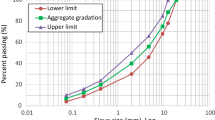Abstract
In this research, Styrofoam in its waste form was first collected, disintegrated, washed and then dried prior to mixing it with asphalt. A 70-80-penetration grade asphalt binder was used and mixed with the processed waste Styrofoam. Mixing percentages of Styrofoam to asphalt (S/A) were: 0.0 % (control sample), 0.2%, 0.4%, 0.6%, 0.8%, 1.0%, 1.2%, and 2% by weight of asphalt binder. Two sets of Styrofoam asphalt binders were p repared. One set of the samples was subjected to only the mixing conditions without further aging (this set consists of the unaged Styrofoam asphalt samples). The other set was subjected to short-term aging using the rotating thin-film oven test. Consistency tests including penetration, ductility, and softening point were conducted on both sets of samples. The flash point test was also conducted on both unaged and aged samples. Superpave tests including the rotational viscosity (RV) and the Dynamic Shear Rheometer (DSR) were performed. Findings of the study found that the addition of Styrofoam to asphalt binders resulted in a significant change in the asphalt binder properties at 5 percent significance level. The ratio of the ductility of aged samples to the ductility of unaged samples ranged from 0.84 to 0.92. On the other hand, the ratio of the penetration of aged samples to the penetration of unaged samples ranged from 0.75 to as high as 0.97. It was also found that the RV and the complex shear modulus (G*) value increased with the increase in the S/A percentage. Styrofoam asphalt binder is expected to produce rutting resistant mixtures that can be used for asphalt pavements at high pavement service temperature s up to 64°C.
Similar content being viewed by others
References
G. Wypych, Handbook of Polymers, Chem. Tech. Publishing, 1st edition, 2012, pp. 541–547. https://doi.org/10.1016/B978-1-895198-47-8.50162-4.
Gaw, A., Zamre, G.S., Renge, V. C., Bharsakale, G. R., and Tayde, S., Utilizationof Waste Plastic in Asphalting of Roads Scientific Reviews and Chemical Communications, ISSN: 2277-2669 vol.2, issue 2, (2012), pp. 147–157.
M. Baker, R. Abendeh, Z. Abu-Salem, T. Khedaywi, Production of Sustainable Asphalt Mixes Using Recycled Polystyrene, Inter. J. Appl. Environ. Sci. 11 (1) (2016) 183–192.
M. I. Nassar, I. K. Kabal, M. I. Ibrahim, Evaluation of the Waste Polystyrene on Performance of Asphalt Binder ARPN, J. Sci. Technol. 2 (10) (2012) 927–935.
S. I. Al-Haydari, G. G. Masued, Benefit of Using Expanded Polystyrene Packaging Material to Improve Pavement Mixture Properties, Appl. Res. J. 3 (11) (2017) 332–342.
A. Abdul-Mawjoud, S. Thanoon, Evaluation of SBR and PS-Modified Asphalt Binders and HMA Mixtures Containing Such Binders, Appl. Res. J. 1 (9) (2015) 460–469.
S. Abinaya, M. Clement, S. Shanmugam, An experimental study on the properties of extruded Polystyrene waste polymer modified bitumen for flexible pavements. Inter. Res. J. Eng. Technol. (IRJET) 3 (6) (2016) 304–308.
R. Maharaj, D. Ramlochan, N. Mohamed, An Evaluation of the Viscoelastic Performance of Polystyrene Modified Asphalt Binders, Progress in Rubber, Plastics Recyc. Technol. 33 (4) (2017) 243–260.
M. Enieb, A. Diab, Characterics of Asphalt Binder and Mixtures Containing Nanosilica, Inter. J. Pavement Res. Technol. 10 (2) (2017) 148–157
S. A. Elkholy, A. M. M. Abd El-Rahman, M. El-Shafie, Z. L. Abo-Shanab, Physical and Rheological Properties of Modified Sulfur Asphalt Binder, Inter. J. Pavement Res. Technol. 11 (8) (2018) 838–845.
X. Lu, S. Said, H. Carlsson, H. Soenen, S. Heyrman, P. Redelius, Performance Evaluation of Polymer Modified Bitumens on a Heavily Trafficked Test Road, Inter. J. Pavement Res. Technol. 7 (6) (2014) 381–388.
American Association of State Highway and Transportation Officials, Standard Method of Test for Viscosity Determination of Asphalt Binder Using Rotational Viscometer, Standard Specifications for Transportation Materials and Methods of Sampling and Testing. AASHTO T316. AASHTO, Washington, D.C., 2008.
American Association of State Highway and Transportation Officials, Standard Method of Test for Determining the Rheological Properties of Asphalt Binder Using a Dynamic Shear Rheometer (DSR) Standard Specifications for Transportation Materials and Methods of Sampling and Testing. AASHTO T315. AASHTO, Washington, D.C., 2008.
Acknowledgments
The authors of this paper would like to acknowledge the deanship of scientific research at the University of Petra for their financial support. In addition, the authors would like to thank Mr. Yazid Al Momani for preparing and testing the samples in this study.
Author information
Authors and Affiliations
Corresponding author
Additional information
Peer review under responsibility of Chinese Society of Pavement Engineering
Rights and permissions
About this article
Cite this article
Ramadan, K.Z., Al-Khateeb, G.G. & Taamneh, M.M. Mechanical properties of styrofoam-modified asphalt binders. Int. J. Pavement Res. Technol. 13, 205–211 (2020). https://doi.org/10.1007/s42947-019-0102-4
Received:
Revised:
Accepted:
Published:
Issue Date:
DOI: https://doi.org/10.1007/s42947-019-0102-4




